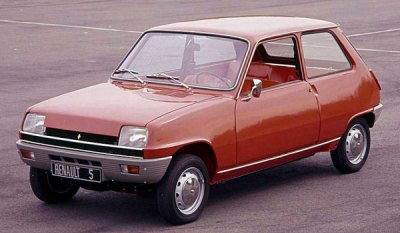 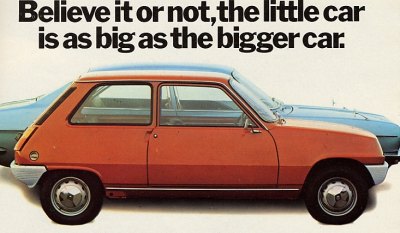 The definitive small car in
the 1960s has to be Mini.
Entering 1970s, the balance tipped towards the newer Renault 5. Unlike
the unpretentious R4, the R5 was designed to
appear young, funky and upmarket. It had a modern shape and could be
painted in eye-catching colors. Its plastic bumpers integrated neatly
with the body shell. Its nose incorporated crumple zone to absorb
impact energy. Its interior was unusually elegant and well finished for
a small car. While its mechanical layout was not as innovative as Mini,
the French car was slightly larger in all dimensions, and it used space
efficiently, so it offered more cabin space than other small cars.
The Renault 5 was also renowned for versatility. As its spare tire was unusually located in the engine compartment, the boot was large and well shaped. A very low boot sill eased luggage loading. Like Renault 4, its rear seats could be folded forward easily to expand luggage space. All in all, its luggage carrying capability would be unrivalled throughout the 1970s. 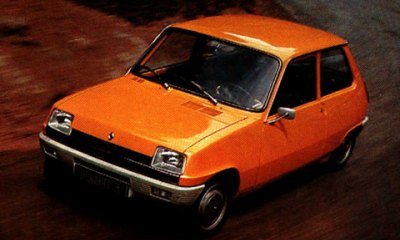 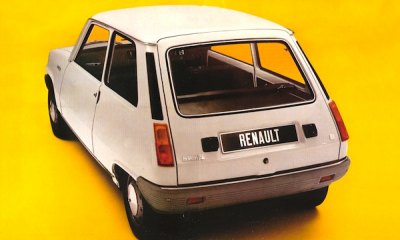 Many of its powertrains and running gears came from R4. Strangely, the four-cylinder-inline engine sat longitudinally aft of the front axle, while the 4-speed gearbox was mounted fore of the engine. This resulted in better weight distribution but awkward gearshift and heavy steering. All engines relied on old-fashioned pushrods to drive 8 valves, but their power outputs were competitive, if not very refined at high rev. The early cars offered 782 cc and 956 cc with 36 and 44 hp respectively. Later on a 45 hp 1.1-liter and 64 hp 1.3-liter joined the range. The suspension system was also similar to R4. The front end had double-wishbones and longitudinal torsion bars while the rear axle rode on trailing arms and transverse torsion bars. They were set to offer ride quality typical to French large cars, i.e. very soft and supple, but the downside was spectacular body roll when rushed through corner. Being practical, comfortable and versatile, the R5 was hugely popular. Its sales rose steadily from 1972 to the peak in 1980, when more than 700,000 units were sold in the calender year. Thereafter it sustained well until the second generation, or Super 5, arrived in 1984. Even so, the original car continued to be produced as a low cost option to buyers until as late as 1992. In total more than 5.5 million copies were sold. The Mk2 might be less commercially successful due to the stiff competition with Peugeot 205 and Fiat Uno (both turned out to be big sellers), but it was still a solid choice to supermini buyers. Compared with the Mk1 it grew slightly larger, more aerodynamic and better built, but the exterior design by Marcello Gandini (famous for Lamborghini Countch) remained familiar. The outdated powertrain layout was finally abandoned for modern transverse unit to improve packaging. The front suspension was simplified to MacPherson struts and coil springs. Consequently, the car was lighter than its precedessor. Its handling was noticeably tauter, but the old engines became less competitive. The Super 5 was officially substituted by Clio in 1990 but again its production carried on until 1996. Fast R5 - Alpine/Gordini (1976), Alpine/Gordini Turbo (1982) and 5GT Turbo (1985) 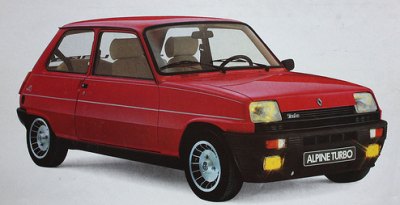 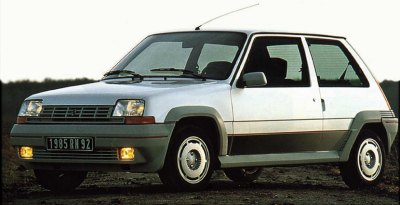 Left: Alpine Turbo; Right: 5 GT Turbo Launched a couple of months earlier than Volkswagen Golf GTI in 1976, Renault 5 Alpine was arguably the first ever hot hatch in the world (note: although the 1961 Mini Cooper and 1972 Alfasud predated them both, they lacked a tailgate to qualify as "hot hatches"). In the UK market where the Alpine name was owned by Sunbeam, this car was called 5 Gordini instead. The Alpine/Gordini had the regular 1.3-liter engine bored out to 1.4 liters and tuned to deliver a respectable 93 hp. Accompanied with a new 5-speed gearbox this lifted its performance to 110 mph and 0-60 mph in 9.7 seconds, which was outstanding. Upgraded wheels, tires and brakes, stiffer suspensions and retuned steering resulted in strong grip, tighter body control and a less heavy steering. Like Mini Cooper, it was nimble and fun to drive on twisty roads. In 1982 the Alpine/Gordini model was upgraded to turbocharged version – Renault was eager to commercialize its turbocharging technology from F1 program. The 1.4 engine was added with a Garrett T3 turbo to produce 110 hp. In terms of straight line speed it was virtually unrivalled, but the turbo installation was poor and pronounced turbo lag hampered drivability and handling seriously. Furthermore, the car suffered from a lot more steering weight and kickback than the naturally aspirated version, so the first turbo experiment was far from successful. In 1985, the second generation R5 revisited turbocharging technology with 5 GT Turbo. It turned to a smaller Garrett T2 turbo and installed the latter close to the now transversely mounted engine, thus reduced turbo lag considerably. Early version produced 115 hp and was found by Autocar capable of topping 125 mph and sprinting from 0-60 in an eye-popping 7.1 seconds! It might be an especially well-tuned car, because later on the same magazine recorded slightly inferior figures (120 mph and 7.3 seconds) on the 1987 version which had been improved to 120 hp. It still suffered from stronger on-power understeer than usual standards, but that was to be expected from a powerful front-wheel-drive hot hatch. The new car adopted a semi-independent torsion-beam rear suspension like Golf to improve body control in corners. Overall, it was a very fast and fun hot hatch, if not as sweet to drive as rival Peugeot 205 GTi. |